If a National Basketball Association franchise featured three Rookies of the Year in a span of five seasons, you’d have to think that team was destined for greatness.
That club was the Buffalo Braves and the three first-year standouts were center Bob McAdoo (1973), point guard Ernie DiGregorio (1974) and forward Adrian Dantley (1977). All three of those former players were among the luminaries that took part in the Legends & Stars memorabilia show today at Batavia Downs Gaming.
Unfortunately for the fans of the Braves (and there were thousands upon thousands of them), the team stayed in Buffalo for only eight seasons – 1970-71 through 1977-78 – before the franchise was relocated to San Diego and renamed the Clippers.
The Braves, behind McAdoo, DiGregorio and hometown hero Randy Smith, were among the elite teams in the league in the mid-1970s, making it to the playoffs three times and losing in a pair of hard-fought six-game series to the Boston Celtics in 1974 and 1976. The Celtics went on to capture the NBA titles in those seasons.
But continued success was not to be as financial concerns, problems with the lease at the old Memorial Auditorium and changes in team ownership led to the franchise’s demise. The city’s loss of the team is still considered to be one of the lowest moments in Buffalo sports history.
The Batavian caught up to the trio during their autograph sessions, posing the question, “What went wrong?”
DIGREGORIO: POINT GUARD EXTRAORDINARE
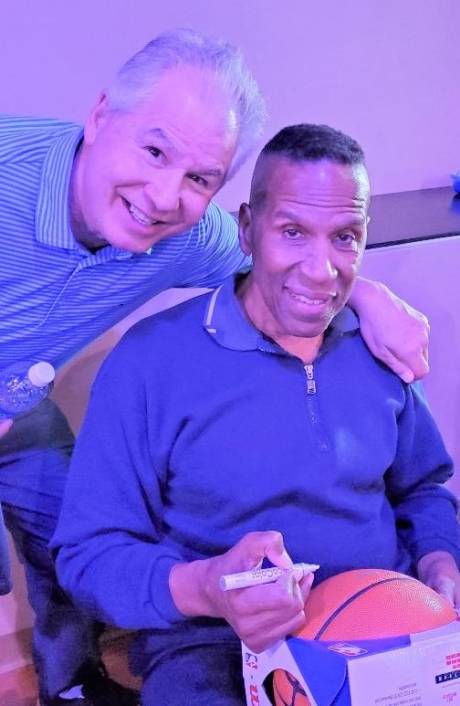
“First of all, I loved playing in Buffalo because as you see the crowds and the fans were tremendous. They loved to support the team,” said DiGregorio, who starred at his hometown Providence College before becoming the No. 3 pick in the 1973 NBA draft. “I had a great time in Buffalo, but the owner of the team, Paul Snyder, had it in his head that he was going to sell the team.
“So, when he started to sell the team to John Y. Brown and made him part-owner, that’s when they started trading Dantley, trading me, trading McAdoo – cleaning house – and everybody knew that eventually the team was going to be moved. So, that was the reason why Buffalo moved from Buffalo to the (San Diego) Clippers.”
DiGregorio, now 71 (the same age as McAdoo and four years older than Dantley), said that in hindsight, it was “a stupid thing to do.”
“A franchise today is worth a billion dollars,” he said. “And he probably sold it for $5 or $10 million … But when the owners have the mindset that they're going to sell, that’s what happened.”
When this reporter mentioned that the NBA became a hot item just three years later when Magic Johnson and Larry Bird burst onto the scene, that prompted DiGregorio to talk about the Braves’ limited appearances north of the border.
“We used to go up to Toronto and play five games a year in Maple Leaf Gardens just to introduce the City of Toronto to the NBA,” he said. “And ironically, as McAdoo told me last night, you can't get a ticket for the Toronto Raptors, they’re sold out (every game). So, it was definitely the wrong move.”
DiGregorio, at 6-foot, had a spectacular rookie season, averaging 15 points per game, while leading the league in assists (his 25 in one game still is an NBA record) and free throw percentage. The following year, however, he suffered a torn meniscus of his left knee and was limited to 31 games.
“It was a torn cartilage. And in those days, they never had arthroscopic surgery,” he said. “So, it was a big thing. They cut it and put you in the hospital for a couple of weeks.”
He shared that the Braves’ head coach, Dr. Jack Ramsay, believed that DiGregorio had lost a step, “but I didn’t believe that. I had all of my career highs after the injury – and it was a common injury. But those are the breaks; I could have got hurt before I even came to Buffalo and would have never made Rookie of the Year. I had my day in the sun.”
DiGregorio went on to play with the Los Angeles Lakers and Boston Celtics after leaving Buffalo in 1977, but his best memories are with the Braves.
“Some of my great games were against the Celtics in the playoffs,” he said. “In fact, my third year, I had been benched most of the whole year. And then I played in the playoffs. And they were writing the headlines in the paper in Boston – Ernie D’s gang is in town. So, proved that I could still play.”

BOB MCADOO: PROLIFIC SCORER
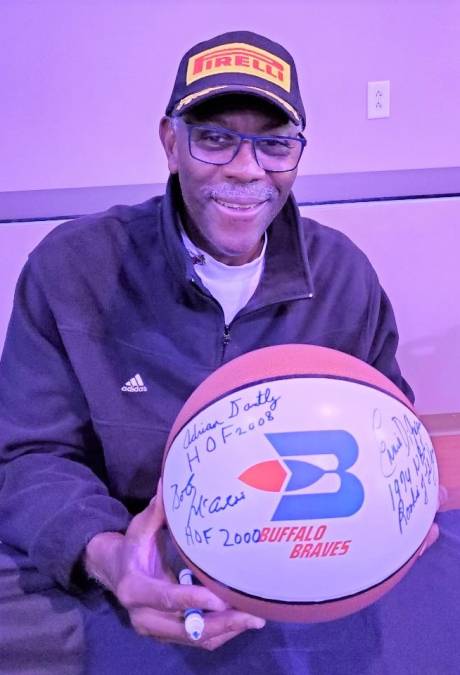
Bob McAdoo, who led the league in scoring average for three straight seasons (30 ppg in 1973-74, 34.5 ppg in 1974-75 and 31 ppg in 1975-76), said he didn’t understand what was going on in the front office – calling it “strictly business” that doomed the franchise.
“When I look back, I see the teams we could have possibly had with Adrian Dantley and Moses Malone, and they ended up trading all three of us that same year (1976-77),” he said. “That was a team that would have been good for the next seven, eight years because we were very young. But you know, as players we don't have any control over what happens with management.”
The 1974-75 NBA Most Valuable Player, the 6-foot-9 McAdoo was the first of the center/power forwards or “stretch fours” that could score from well beyond the paint. He was a scoring machine, earning the call “Two for McAdoo” from Buffalo Braves radio personality Van Miller.
But he saw the writing on the wall when John Y. Brown didn’t meet his contract demands.
“I got traded to the Knicks in the middle of the season,” said McAdoo, who went on to win two NBA titles as a member of the 1981-82 and 1984-85 Lakers.
When asked if he any expectations when he joined the Braves as the No. 2 overall pick of the draft, McAdoo said he “didn’t have a clue until Ramsay started me in December.”
“This is after Bob Kaufman got hurt, and he inserted me into the lineup. And from December to the end of the season, my rookie year, I averaged 33 points a game. That’s when I kind of knew that I could score with anybody in this league.”
McAdoo, who played one year at the University of North Carolina, was inducted into the Naismith Memorial Basketball Hall of Fame in 2000.
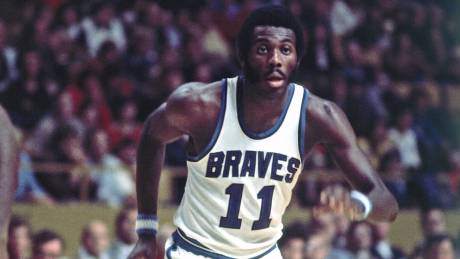
ADRIAN DANTLEY: SIX-TIME ALL-STAR
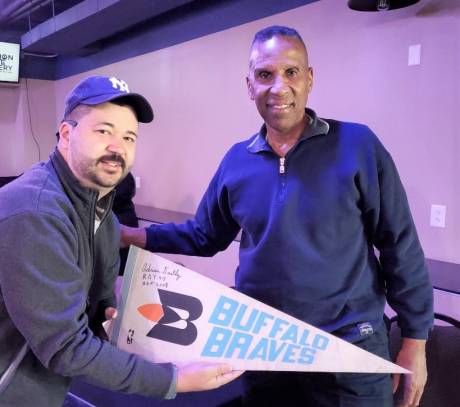
Dantley, the former University of Notre Dame star who was instrumental in ending UCLA’s 88-game winning streak in 1974, just shook his head when wondering what could have been.
“We lost the team because it was all about finances,” he said. “And we had two different owners and each owner was trading away players during the year. So, we never got to be what we thought it might have been.
“In our frontcourt, we had three Hall of Famers – Moses Malone, who they traded before the season; McAdoo, who was traded about 30 games into the season, and then they traded me at the end of the season. We talk about that all of the time. How great of a team that could have been with Ernie D and Randy Smith.”
Dantley recalls “getting bounced around” from team to team in his early years. He played with seven teams, in all – Buffalo, Indiana, Lakers, Utah, Detroit, Dallas and Milwaukee.
“When I went to Indiana, I remember the coach telling me to not buy a house because we’re going to be trading you in a couple weeks,” he said. “That took about 20 games and then I went to LA.”
At the end of his 15-year NBA career, Dantley had a scoring average of 24.3 and, in 2008, was inducted into the Hall of Fame.
“For me, it was about perseverance,” he said. “Nobody likes to get traded. But, I guess you could say that I had a pretty good career.”
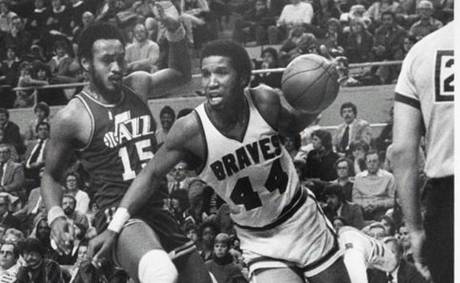
Photos from Legends & Stars show by Mike Pettinella.
